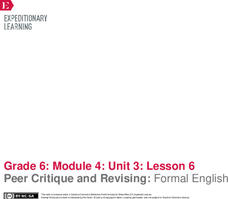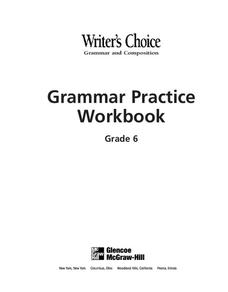EngageNY
Putting the Law of Cosines and the Law of Sines to Use
Use the Law of Cosines and the Law of Sines to solve problems using the sums of vectors. Pupils work on several different types of real-world problems that can be modeled using triangles with three known measurements. In the process,...
EngageNY
Peer Critique and Revising: Formal English
Dear Sir or Madam: What's the difference between formal and informal language? Scholars focus on using formal English and transitions in their position papers. After revising their rough drafts, they engage in the peer editing process...
ReadWriteThink
Exploring Plagiarism, Copyright, and Paraphrasing
Plagiarism, copyright, and fair use are the focus of a three-part instructional activity designed to inform scholars of how to properly cite others' work. First, pupils use a KWL chart to begin thinking and discussing plagiarism. They...
Facing History and Ourselves
Taking Ownership of the Law
The work of building and maintaining a democracy is, in the words of Justice William Hastie, "never finished." To better understand what Hastie sees as an ongoing building process, class members listen to a seven-minute podcast about two...
EngageNY
Studying Conflicting Interpretations: Perspectives on Plessy v. Ferguson: Part 3
Scholars closely read Justice John Marshall Harlan's dissenting opinion in the Plessy v. Ferguson case, seeking to understand why he disagreed with the court's decision that racial segregation laws for public spaces were constitutional....
EngageNY
Mid-Unit 3 Assessments, Part 1: Summarizing, Analyzing and Discussing Research
Speak up and listen up. Scholars participate in a speaking and listening mid-unit oral assessment. They discuss whether their rules to live by should be a personal choice or made into a law, and then they complete an exit ticket to...
Alabama Department of Archives and History
Alabama BEFORE the American Revolution
Did you know that prior to the American Revolution, Alabama was a part of the British empire and called New West Florida? Class members research the economic, political, and social realities of this territory and compare them to those of...
Texas Education Agency (TEA)
Evaluating the Effectiveness of Arguments, i.e., Identify Fallacies (English III Reading)
A series of interactive exercises provide users with the ammunition they need to detect logical fallacies and defend themselves against persuasion. Learners read about 11 types of logical fallacies and identify the type used in sample...
Smarter Balanced
Intellectual Property
To prepare for a study of intellectual property rights, (or an assessment) introduce your learners to the legal concepts and key vocabulary associated with the debate. After defining intellectual property, copyright, fair use, and...
ESL Kid Stuff
Christmas Lesson 2
Wrapping presents, singing Christmas carols, writing Christmas cards and learning holiday vocabulary are all wrapped into this one exciting ESL lesson.
EngageNY
Grade 9 ELA Module 4, Unit 1, Lesson 11
As part of a study of how writers structure their text so that readers understand events, class members do a close reading of "Is It Lawful to Make Slaves of Others Against Their Will?" a chapter in Aronson and Budhos' Sugar Changed the...
EngageNY
Determining Central Ideas: The 14th Amendment
What is the central idea of the Fourteenth Amendment? Scholars attempt to answer the question as they read and discuss the Fourteenth Amendment to the United States Constitution, which guarantees all citizens equal protection of the...
EngageNY
Mid-Unit 3 Assessments, Part 2: Summarizing, Analyzing and Discussing Research
Why is reading important? As part of the mid-unit assessment, scholars read, summarize, and analyze an article about the importance of reading. Additionally, they continue their discussion about whether their rules to live by should be a...
EngageNY
Reading for Gist and Answering Text-Dependent Questions: Chapter 5 of World without Fish
Discover the rules of fishing. Pupils read chapter five of World without Fish to discover ideas about the rules and laws of fishing. They use sticky notes to annotate text as they read about fishing in other countries. They focus on the...
ProCon
Gun Control
According to some estimates, there are more guns than people in the United States. Learners decide if America should enact more gun control laws. They analyze information about gun deaths in the United States by year, read about the...
ESL Kid Stuff
Past Tense Activities - Irregular Verbs: Part 1
As part of a series of resources designed for English learners, a language arts lesson prompts kid engage in activities and exercises that focus on the past tense of irregular verbs.
ESL Kid Stuff
Adverbs
Run quickly. Walk slowly. Jump high. As part of their study of English parts of speech, language learners engage in a series of activities designed to introduce them to the descriptive power of adverbs.
ESL Kid Stuff
Seasons
English language learners celebrate the seasons with games, songs, and readings.
Azar Grammar
Song Lessons: What a Wonderful World
Here's a wonderful way to learn English grammar. Class members examine the plural count nouns in Thiele and Weiss's "What a Wonderful World," reading the lyrics as they listen to Louis Armstrong's version of this classic song.
Schoolwires
12th Grade Expository Reading and Writing Research Project
The beauty in this resource is the lengthy list of highly charged, controversial-issue research topics. Categories include issues of race, politics, law, environment, education, athletics, gender, and technology. After selecting a topic,...
K12 Reader
Robert Burns’ Poetry: A Red, Red Rose
Regional dialect can make a lovely poem even more beautiful. After translating the Scots words in "A Red, Red Rose" into modern English, class members identify the two similes Robert Burns uses in his poem.
Azar Grammar
Song Lessons: Father and Daughter
Paul Simon's "Father and Daughter" offers language learners and native English speakers an opportunity to study adverb, adjective, and noun clauses.
McGraw Hill
Grammar Practice Workbook
To an English teacher, the only sound worse than nails on a chalkboard is a student using improper grammar. Make poor grammar a problem of the past with this extensive collection of worksheets that covers everything from sentence...
EngageNY
Mid-Unit Assessment: Completing My Draft Position Paper
What's the difference? Scholars analyze the similarities and differences between introductory and concluding paragraphs. Then, using a model essay as a guide, they write their draft position papers.
Other popular searches
- English Law Courses
- Magna Carta, English Law
- Magna Carta English Law
- English Law Corses
- Maegan Car Ta, English Law
- English Law Contract
- Maegan Car Ta English Law
- Magna Carta\\, English Law
- Magna Carta\, English Law
- Magna Carta\\\, English Law
- Maegan Car Ta\, English Law
- English Common Law Labor

























